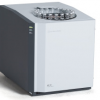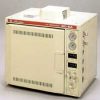- The open access, 90-position sample tray provides immediate access to all samples at all times
- Uses standard, round-bottom 10-mL and 20-mL headspace vials without adapters
- The 12-position equilibration oven loads from the bottom to minimize heat loss and improve repeatability
- Maximum equilibration temperature of 300 °C permits analysis of high-boiling compounds
- Includes multiple operational modes: static headspace mode, headspace-trap mode (HS-20 Trap model only), multiple headspace extraction (MHE) mode, and method development mode
- The headspace needle, passivated loop, and trap (HS-20 Trap model only) are easily accessible from the top of the instrument for routine maintenance
- An optional bar-code reader logs sample ID for traceability
- Can be used for GC or GCMS analysis – the GC version is compliant with FDA CFR 21 Part 11
Premier Solution for Volatile Component Analysis
Principle of headspace (HS) analysis: A sample is sealed inside a HS vial, and the VOCs in the sample are allowed to reach equilibrium between the gas and liquid phases using temperature, agitation, and time. The vial is pressurized and a portion of the headspace is sampled for analysis.
The HS-20 Loop Model is designed to be used for traditional static HS applications and methods using the pressure-loop sampling technique. The HS-20 LongTX Model is identical to the HS-20 Loop Model, but interfaces to the GC-2014 gas chromatograph through a longer (60-inch) transfer line.
The HS-20 Trap Model can be used for the traditional static HS applications, and for applications requiring greater sensitivity via the HS-trap technique. Volatiles from the HS are sampled up to 10 times, and concentrated on a Peltier-cooled adsorbent trap prior to desorbing to the GC or GC/MS for analysis.
Analysis of volatile components by the HS technique is used for environmental samples, materials characterization, pharmaceutical residual solvents, determination of blood alcohol, and a wide range of other applications.




